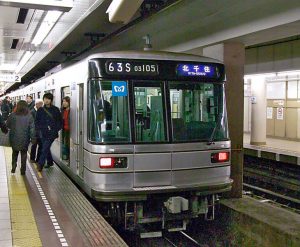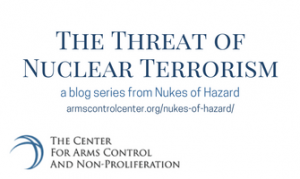By Anna Schumann
 I can’t say I’d ever spent too much time thinking about nuclear terrorism before former Secretary of Defense William J. Perry’s class on the issue. I have spent most of my life in America, so the alarming scenarios that clutter my mind typically involve a mass shooting on the public transit I use daily in Washington, D.C., or in one of the hundreds of buildings with no discernible security I enter each year. But I’m old enough to remember September 11 vividly — life before it, and how everything was suddenly different after it. Perhaps that means I should have been more aware of potential terrorist threats ever since. After this week’s lesson, I definitely am.
I can’t say I’d ever spent too much time thinking about nuclear terrorism before former Secretary of Defense William J. Perry’s class on the issue. I have spent most of my life in America, so the alarming scenarios that clutter my mind typically involve a mass shooting on the public transit I use daily in Washington, D.C., or in one of the hundreds of buildings with no discernible security I enter each year. But I’m old enough to remember September 11 vividly — life before it, and how everything was suddenly different after it. Perhaps that means I should have been more aware of potential terrorist threats ever since. After this week’s lesson, I definitely am.
This week’s coursework began with a video aptly titled “Dr. Perry’s Nuclear Nightmare.” In it, terrorists — those not working on behalf of any particular state — successfully enrich uranium, transfer it to a lab to create a bomb and ship the bomb via civilian transit to the United States. Once inside our borders, terrorists load the bomb into a truck, and have an American citizen who is in on the plan pull the truck into D.C. traffic to detonate it. It kills 80,000 people instantly, including every top government official. The Senate Pro Tempore, fourth in the order of succession, was in Minnesota undergoing treatment for cancer; he is now president. Newsrooms nationwide receive messages that there are five more bombs in different American cities, and that one will go off every week for the next five weeks until all American troops overseas are sent back to the U.S. There is widespread panic; all communications networks are down; crime escalates and marshal law is implemented.
The video was terrifying, and not only because in this scenario, I am instantly killed. Not only because my thoughts immediately go to my family in Texas, who would be devastated (I think) over losing me, and terrified of becoming victims of a future attack. Not only because I worry about the millions of people across the country who would die even if they survived an attack because they couldn’t get needed prescriptions, food or shelter. And not only because it would mean there was yet another moment by which survivors would define their lives: pre-attack and post-attack. What terrifies me most is the idea that our government, our institutions and the democracy we have painstakingly worked to preserve and improve over the last 240 years could face so much destruction in such a short period of time. Things we have built and torn down and rebuilt could now be beyond repair.
Dr. Perry notes that while hypothetical, the scenario is based on facts. And while we might not want to think about such scenarios, we must. We must acknowledge the possibilities of these scenarios so we can work toward their prevention.
Thankfully, we have not had a nuclear terror attack on an American city…yet. Other terrorist events involving weapons of mass destruction have happened. One discussed in great length this week was orchestrated by Aum Shinrikyo, an apocalyptic cult that carried out a chemical attack in the Tokyo subway system in 1995, killing a dozen people and injuring thousands. Margaret Crenshaw, senior fellow at the Freeman Spogli Institute for International Studies at Stanford University, said Aum Shinrikyo was able to pull off this attack in orderly Japan because it was considered a religious group and therefore free from government surveillance. It operated above-ground and was legal. It actively recruited and hired scientists — though not great ones — to help it acquire nuclear capabilities. After attempts at acquiring the materials necessary to create a bomb were unsuccessful, and as Aum Shinrikyo believed the apocalypse was quickly nearing, the group opted instead for chemical weapons. They released sarin gas on the subway and, while it was damaging and many were killed, the scientists they hired produced a weak gas and hadn’t identified a way to disseminate it to maximize destruction. As bad as the attack was, it could have been much worse.
Dr. Perry said groups like Aum Shinrikyo haven’t pulled off similar attacks in the United States because domestic intelligence is quick to infiltrate groups as soon as they are discovered. I believe in the power of U.S. intelligence, but it’s important to acknowledge that things slip through the cracks. As Dr. Crenshaw said, since 1993, 15 attacks that could have been catastrophic to the United States were prevented thanks to foreign intelligence. That information leads me to one obvious, but unfortunately increasingly unpopular opinion: Countries must continue working together to prevent disasters. Groups like ISIS and Al-Qaeda are alive and well, and have engaged in chemical attacks against their enemies. Now is not the time to isolate friends and allies, to strain relationships over agreements that are working, and to make (hopefully empty) threats to peace. Because if a nuclear terrorism attack is even a small possibility, we’ll need all the help we can get to prevent it. I have to hope that the survivors in the hypothetical video would all strive to create a better world than they remembered before the attacks — a world in which such attacks weren’t possible.
This post is part of a series. Read the first one.

